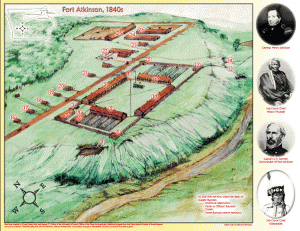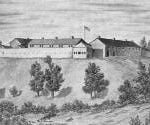
In 1840 the Winnebago Indians were removed to their new home on the Neutral Ground. In order to protect them from the incursions of their neighbors, among whom were the Sauk and Fox tribes, as well as from intrusions of the whites, and in turn to prevent them from trespassing beyond the limits of the reservation, soldiers were stationed among them. A detachment of the 5th Infantry (Company F) under command of Captain Isaac Lynde left Fort Crawford, with a complement of eighty-two officers and enlisted men, and went into camp, May 31, 1840, in the neighborhood of Spring creek (now known as Goddard’s creek) on the Turkey river. The camp was named “Camp Atkinson” in honor of Brigadier General Henry Atkinson, U. S. Army, the Department Commander who was so prominent in military operations in the upper Mississippi valley. Barrack and quarters sufficient to accommodate one company were erected, and in March, 1841, the Secretary of War ordered that the station be known as Fort Atkinson.
Rumors of the warlike attitude of a portion of the Sauk and Fox Indians, who, it was believed, intended sending out a party against the peaceable Winnebagoes, caused Governor Dodge of Wisconsin, in a letter dated January 23, 1847, and directed to the Commissioner of Indian affairs, to urge strongly that, in addition to the garrison there at that time, a mounted force be stationed at Fort Atkinson. The following is an extract from Governor Dodge’s letter:
“In compliance with the instructions of your Department the Agency and School have been removed to the new site on Turkey river with about l00 of the Indians of the Winnebago Nation. These Indians, it is confidently expected, will not return, unless another blow should be struck by the Sauks and Foxes. Such an event may not be looked for this winter, but it is the opinion of Mr. Lowry that it may certainly be calculated upon in the ensuing spring unless a mounted force should be stationed at Camp Atkinson.
“Information was received by Mr. Lowry through Governor Lucas, obtained from a portion of the Sauks and Foxes not unfriendly to the Winnebagoes, that a war party was to have set out against the latter in November last. A very extraordinary snow storm is believed to have prevented this attack. The war party is now on Red Cedar (fifty miles west of Camp Atkinson); a large body of Sioux are also in that vicinity, and scouts of the former have been fired at by the latter but as yet no blood has been shed. The difficulty of keeping the Winnebagoes at their new homes, under these circumstances, and without an adequate force for their protection, must be readily seen.”
This letter was referred to the War Department, where it was in turn referred to General Atkinson with instructions to use every effort to prevent any collision between the Indians. General Atkinson responded to these instructions March 1, 1841, as follows:
“Sir: I have the honor to report, that I have received your letter of instructions of the 15th ultimo, accompanied by an extract of a letter from Governor Dodge of the aid of January, in reference to establishing a mounted force at Fort Atkinson for the protection of the Winnebago Indians. It is impossible to station a mounted force at that point before the middle of May, as there are no barracks, quarters or stables for their accommodation, nor forage for their horses. I will, however, order the troop at Fort Crawford to make excursions through the country of Turkey and Cedar Rivers, till the season opens to enable it to go under tents, at which time the grass will be grown sufficiently to subsist the horses.
“No time should be lost by the Quartermaster’s Department in proceeding to erect quarters, barracks, and stables for the troop at the post on Turkey River, or they will not be ready for their accommodation by the coming of the next winter. I request, therefore, that orders to that effect may be given without delay.
“With great respect, Sir, your most obedient servant,
(Signed.) H. Atkinson, Brigadier General U. S. Army.
Brigadier General Jones,
Adjutant General U. S. Army, Washington.”

On the 24th of the following June, Company B of the 1st Dragoons arrived at the fort and took up their station, and from that time until 1847 the fort was a two-company post. September 11th Captain Lynde’s company was relieved by Company K of the 1st Infantry, Captain J. J. Abercrombie.
In the year following, at various times, on the requisition of Governor Chambers of Iowa Territory, detachments and patrols were sent out from this fort to remove squatters and other intruders from the lands of the Sauk and Fox Indians and to prevent their return. August 7th Company I, 1st Dragoons, under Command of Captain James Allen, arriving at the fort, whence they proceeded to the Sauk and Fox Agency, where they established Fort Sanford. From this time until its abandonment Fort Atkinson was successively garrisoned by the following organizations.
Company B, 1st Infantry, Captain Sidney Burbank; Company A, 1st Infantry, Captain Osborne Cross; Company F, 1st Infantry, Captain A. S. Miller; Company A, 1st Iowa Volunteer Infantry, Captain James M. Morgan; Company A, 1st Iowa Volunteer Dragoons, Captain John Parker; a detachment of Wisconsin Volunteers, Dodge Guards, under command of Lieutenant Benjamin Fox; (here was an interim of several months during which the Fort was not garrisoned;) and from September 25, 1848, until the time of its abandonment, Company C, 6th Infantry, Captain F. L. Alexander. 1
The fort was situated in the northwestern part of Washington township (on the old military road constructed from Fort Snelling to Fort Gibson) and stood on a rock-ribbed hill overlooking the site of the town which now bears its name. This hill is about eighty-four feet above the Turkey river. The fort buildings were two stories high, twenty feet to the eaves. Each building had an upper porch along its entire length, the one on the officers’ quarters being screened in with the old fashioned movable wooden blinds. The buildings occupied an acre of ground. The stables, about 40 feet wide and about 300 feet long, extended north and south and were about 20 rods east of the street. The bakery, and the blacksmith shop and carpenter shops were north of the fort on the north side of the street.
Citations:

